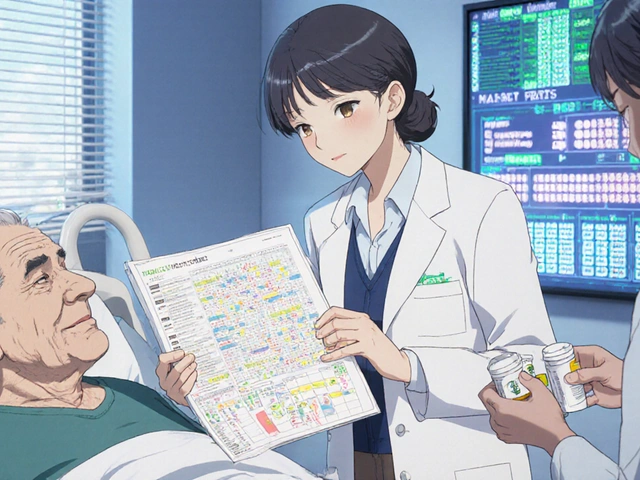Picture this: a tiny purple pill quietly working to stop the next heart attack or stroke. Every day, millions count on Plavix to keep life running smoothly, but how exactly does it work? Is it really as safe as everyone hopes? There’s a lot more to this high-profile blood thinner than meets the eye. Whether you're already taking Plavix, or just learned you might need it, understanding what’s going on inside your body can take the stress down a notch.
How Plavix Works and Why Doctors Prescribe It
Let’s get into the nitty gritty. Plavix, known in pharmacies as clopidogrel, isn’t like regular painkillers or cold medicine—it’s what’s called an “antiplatelet medicine”. That’s a fancy way to say it helps keep your blood from getting too sticky. We all need our blood to clot if we’re cut (otherwise, we’d be in trouble), but too much clotting inside veins or arteries is downright dangerous. That’s the stuff strokes and heart attacks are made of.
So why do doctors reach for Plavix? Most commonly, it’s given after a person’s had a heart attack, stroke, or a stent put into their heart. Here’s why: these medical events usually mean there’s already some blockage or narrowing in your blood vessels. Extra-sticky platelets can make things worse by creating new clots—Plavix makes it harder for those nasty clots to form. But that’s not all. Some folks have certain heart rhythm problems (like atrial fibrillation) or diseases in their arms and legs that put them at higher clot risk. A doctor might choose Plavix for these, too, especially if aspirin alone doesn't cut it.
Here’s a quick table showing common reasons your doctor might hand you a Plavix prescription:
| Reason for Plavix | Details |
|---|---|
| After a heart attack | Prevents new blood clots in damaged arteries |
| Stent placement | Keeps stents open by stopping clot buildup |
| Recent stroke | Lowers the chance of another stroke |
| Peripheral artery disease | Improves blood flow in narrowed arteries of legs |
| Certain heart rhythm issues | Reduces clot risk, sometimes with aspirin |
It’s fascinating that chemists first cooked up clopidogrel back in the 1980s, and by 1997, the FDA gave it the green light. Since then, it’s become one of the world’s blockbuster medications. Reports from the Centers for Disease Control say more than 20 million American adults pick up a prescription for Plavix or its generics every year. Even dogs with heart conditions sometimes get a version of it. Talk about a wide reach!
But what actually happens in your body? Plavix messes with a unique chemical handshake between platelets, making it tough for them to stick together and start a clot. The result: blood keeps moving, and the risk of emergency drops. Pretty amazing for one pill. The real kicker? Plavix doesn’t work the same speed for everyone. Your genes, your liver, and even what other meds you’re on all play a part. Certain people break it down so slowly (or so fast) that a genetic test might be in order—let your doc know if unusual bruising or clots pop up while you’re on it.

Managing Risks, Side Effects, And Drug Interactions
Every pill’s got its tradeoffs, and Plavix is no exception. Let’s be real: anytime you mess with blood clotting, there’s a chance of too much bleeding. That’s the number one side effect that pops up, but the details are worth digging into. Nosebleeds that won’t stop, dark urine, bloodshot eyes, or bruises the size of apples—if you notice these and you’re on Plavix, don’t brush it off as nothing. Head straight to your doctor or the ER. Little nicks and cuts can also bleed longer, so always keep that in mind when shaving or chopping veggies.
There are some rare but serious reactions. One is called TTP (thrombotic thrombocytopenic purpura)—yes, a real tongue-twister—which shows up as purple spots on the skin, fever, or confusion. It can hit fast, so any of those signs mean emergency time. Allergy symptoms (rash, swelling, trouble breathing) are on the list, too, even if you’ve taken Plavix for years with no trouble before. The good news? Most people don’t get major side effects, but everyone should be alert.
Let’s talk drugs and food. Plavix loves to play nice, but there are a few troublemakers on the block. Here’s what to watch for:
- Omeprazole and esomeprazole: These heartburn meds can mess with how well Plavix works. Your doctor can swap them for something like pantoprazole if you need stomach help.
- Other blood thinners: Mixing Plavix with warfarin, rivaroxaban, or aspirin can make you bleed even quicker. Your doctor weighs these risks if you really need both.
- Some antidepressants: SSRIs (like fluoxetine) can also boost bleeding risk.
- Certain seizure meds: Carbamazepine and phenytoin might lower how much Plavix is working.
As for food, you can eat pretty much anything, but keep grapefruit and grapefruit juice on your radar. There’s mixed evidence, but some research hints it could affect the way your body handles certain meds, maybe including Plavix. Best to play it safe and skip that morning glass.
One surprising tip: always mention Plavix before dental work or surgery. Even a simple tooth cleaning can turn messy. Doctors or dentists may tweak your schedule, and sometimes you’ll need to stop and restart Plavix based on their call.
Here’s a table of common side effects and how often they’re reported, based on real-world data from pharmacy case studies:
| Side Effect | Frequency |
|---|---|
| Bruising | Up to 5% |
| Nosebleeds | About 2% |
| Serious bleeding (stomach, brain, etc.) | Less than 1% |
| Allergic reactions | Rare (<0.1%) |
| TTP | Very rare (<0.01%) |
Remember, Plavix can take several days before it’s working at full strength. If you miss a dose, just take the next one when you remember—don’t double up.

Real-World Tips For Living With Plavix
Plavix isn’t just another item in the pill organizer; it can totally change how you go about daily life. That also means there are some tips that make things a lot easier.
- Keep a medical alert card in your wallet. If you end up in the ER and can’t talk, the staff need to know you’re on a blood thinner. Some pharmacies even give out free cards.
- Choose soft toothbrushes and electric razors. They make it less likely you’ll get a mouth bleeding or end up looking like you wrestled a badger.
- Set reminders for your doses. A missed dose might not feel like a big deal, but missing several cuts short the protection Plavix offers. Smartphone alarms or pillboxes do the trick.
- Talk before trying supplements. Even “natural” stuff like ginkgo or turmeric can mess with clotting. Always check with your doc first.
- If you fall or hit your head, get checked. Internal bleeding can sneak up on you, even if you feel OK at first.
- Know it’s for the long haul (sometimes). Many people take Plavix for at least 6 to 12 months after heart treatments. Some stay on it for years. Don’t quit early unless your doctor gives the green light.
- Ask about getting regular blood work. Unlike warfarin, Plavix doesn’t need constant monitoring for most people—but your doctor may want to check blood counts, especially if you’re bruising a lot.
- Remember, not all generics are created equal. Some folks feel better on one generic brand than another, usually because of the fillers. If you notice weird side effects after a pharmacy switch, speak up.
- Plan smart around travel. Always bring enough Plavix for your full trip—and a few extra days—just in case of flight delays or lost luggage. Plavix is stable at room temperature, no special storage needed, so you’re good to toss it in your bag.
Ever wondered how doctors decide if you even need Plavix? They use risk calculators that factor in your age, what happened (heart attack, stroke, stent), and other medicines you’re taking. Sometimes, patients who can’t take aspirin get Plavix instead, or both (that’s called “dual antiplatelet therapy”). But too much of a good thing means bleeding goes up, so it’s a balance between keeping your arteries clear and not springing leaks left and right.
Cost is a real concern for lots of folks, especially now that insurance companies are tightening their belts. Being on one of the world’s most well-known heart meds means there are now plenty of cheaper generic options. It pays to ask your pharmacy if they can switch you, since the savings can be huge—sometimes less than $10 a month out of pocket.
By the way, what if you forget a dose? No need to panic. Most doctors say to just skip and take the next dose on time—never double up. If you keep forgetting, a simple hack is to time your dose with something you never skip, like brushing your teeth at night or your first cup of coffee in the morning.
So here’s the bottom line: Plavix has a huge impact, but it’s not a “set it and forget it” sort of situation. You’ve got to be aware, stay smart about little risks, and always keep an open line with your health team. People who do that usually manage this powerful medicine just fine, no matter if it’s for a year or a lifetime. If you’ve got questions about anything new or odd that pops up after starting Plavix, put in that call. When it comes to your heart, there’s no such thing as a silly question.







11 Comments
Honestly, I’m super suspicious about Plavix and all these so-called blood thinners that Big Pharma pushes on people. They want you hooked on medications, manipulating populations under the guise of “heart health” — it’s a racket to keep making billions.
Like, do people even stop to question what they’re really putting into their bodies? And these supposed warnings about food interactions and side effects? Sounds like they’re just covering their butts for all the cases they poison daily.
I’m all for natural remedies, lifestyle changes, but the blind trust? No way. Research before swallowing every pill they shove down your throat!
And anyone else feel this way? Seems like we need to wake up instead of blindly following doctors because they wear white coats.
Bruh, gotta say this whole Plavix thing gives me serious vibes of sleazy health-industrial complexes just feedin us poison while pretendin to care, ya kno?
Corrupt docs pushing meds like candy when all u really need is a damn lifestyle overhaul and some turmeric or holy basil or somethin. Plus, peeps hardly ever spill tea on the long-term damage these blood thinners do–it’s all hush-hush, just pure pharma agendas.
Like seriously, watch your diet and avoid the crap these big pharma dudes say at your own risk! Side effects? The list’s a novella. These pills don’t deserve our blind trust, they deserve heavy scrutiny.
I understand why this post is important especially for those who have been prescribed Plavix. It’s such a complicated medication to navigate not just because of its physical effects but also the mental and emotional toll taking blood thinners can have on a person.
Living safely with Plavix means more than just avoiding certain foods or medicines; it’s about monitoring yourself constantly, having open communication with your healthcare provider, and listening closely to your body’s signals. I’ve seen many people struggle silently with the fear of bleeding or other side effects.
It’s crucial to advocate for yourself, ask questions, and not be rushed in decisions about your care. Each patient’s experience with Plavix is unique, so personal support networks often help immensely.
The article covers the basics adequately but to truly understand a drug like Plavix, one must delve deeper into pharmacodynamics and the clinical trial data. Its role in inhibiting platelet aggregation is critical, yet the nuances of its interaction with cytochrome enzymes and other medications are often overlooked in casual write-ups.
Moreover, risk stratification in patients necessitating Plavix should be individualized rather than a blanket prescription. The one-size-fits-all approach is antiquated in the modern medical landscape.
Those interested in comprehensive insight should consult peer-reviewed journals and clinical guidelines rather than generalist summaries. This is a matter where precision in knowledge correlates directly with patient outcomes.
Look, as someone from India where healthcare practices can be wildly inconsistent, this article is decent but misses out on regional realities. Plavix might be prescribed without proper diagnostics or patient education here, which is dangerous.
The dose, duration, and monitoring should not be taken lightly. Many patients discontinue meds due to ignorance of side effects or can’t afford follow-ups. It’s a big problem. Awareness campaigns in such countries are desperately needed.
What’s your take on affordable access to safer alternatives? Because the policy gap is huge and sometimes what works in the West doesn’t translate well here.
Ugh, the typical narrative is so sanitized it glosses over all the catastrophic adverse events these anticoagulants sometimes cause, like hemorrhagic strokes or severe GI bleeds. The jargon thrown around makes it sound like a walk in the park.
Plus, the moralizing tone about compliance seems almost guilt-trippy. Patients freaking need realistic guidance on balancing risks, not being shamed for having normal doubts about a drug with such potent measures.
Does anyone else here think the medical establishment sugarcoats these risks? The article could be more honest about the brutal realities some patients face.
It’s obvious to me that Plavix and the entire anticoagulant market is just a cog in a vast machinery designed to keep people dependent on pharmaceuticals. The inconvenient truth about side effects and contraindications is intentionally buried beneath layers of marketing and “approved” literature.
Governments and corporations alike benefit from prolonging these treatments, regardless of the detrimental long-term impact on human health. Ever notice how most studies about these drugs are funded by the companies producing them?
Our best recourse is to question every single prescription and educate ourselves before blindly accepting the so-called expert opinions.
From my experience, Plavix can be a lifesaver but it’s definitely not without its complications. People gotta realize there’s no magic pill—managing side effects and drug interactions is a headache in itself.
Also, patients often complain about bruising, bleeding gums, and fatigue — stuff that seriously affects daily life. It’s crucial to stay vigilant and report anything unusual ASAP.
Doctors sometimes underestimate how overwhelming it gets for the patient juggling multiple meds. This article could’ve emphasized more on the quality-of-life aspect while on Plavix.
Honestly, I feel like blood thinners like Plavix are both a blessing and a curse. They help prevent nasty clot-related events but also introduce this shadow of constant risk.
My uncle was prescribed it and he’s now scared to even cut vegetables, thinking he might bleed out from a tiny nick. The psychological burden is no joke.
Posts like this one are helpful but shouldn’t shy away from discussing the anxiety and mental health effects alongside the physical considerations.
Would love to hear how others cope with that stuff while on meds like this.
Well, addressing the metaphysical aspects underlying our reliance on pharmaceutical interventions, one might argue that Plavix symbolizes the precarious balance between human fragility and technological triumph.
That said, it is vital to critically engage with both the scientific and the existential dimensions of such medications. Our bodies, interwoven with complex biochemical tapestries, respond to these external agents in ways that challenge simplistic narratives of health and sickness.
Thus, a holistic understanding entails not only pharmacological knowledge but also a reflective awareness of the ethical and phenomenological considerations implicit in therapies like Plavix.
Personally, I find it fascinating how medications like Plavix are both profoundly beneficial and inherently risky. It highlights the duality of modern medicine, where interventions meant to protect us carry their own dangers.
The balance between preventing clotting and risking bleeding requires careful judgement, informed by evidence but tempered with individual patient context.
In my view, ongoing dialogue between patients and clinicians is essential to navigate these therapeutic tightropes effectively. Articles like this one are an important step in fostering that communication.
Write a comment